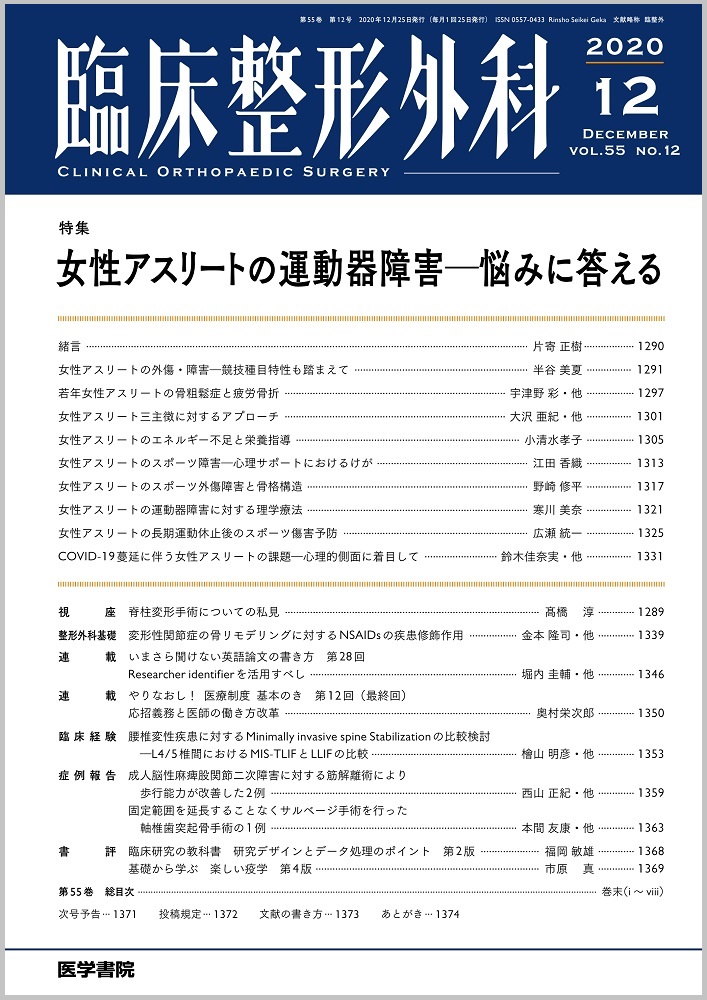文献詳細
特集 女性アスリートの運動器障害—悩みに答える
文献概要
近年,女性アスリートへの支援は多方面から行われている.しかしながら,女性は月経や妊娠,出産,結婚などライフイベントの影響を受けやすく,継続的かつ包括的な支援体制の充実が望まれる.
男性との骨格や性ホルモンなどの違いから,女性アスリートで好発する障害の特徴も少し異なる.また,理学療法では,身体構造や生理学的特徴,心理社会的状況を理解して進めていくべきである.
そこで本稿は,女性アスリートに好発する運動器障害と理学療法について紹介し,女性アスリートへの包括的支援のあり方を紹介する.
男性との骨格や性ホルモンなどの違いから,女性アスリートで好発する障害の特徴も少し異なる.また,理学療法では,身体構造や生理学的特徴,心理社会的状況を理解して進めていくべきである.
そこで本稿は,女性アスリートに好発する運動器障害と理学療法について紹介し,女性アスリートへの包括的支援のあり方を紹介する.
参考文献
1) Shultz SJ, Shimokochi Y, Nguyen AD et al. Measurement of varus-valgus and internal-external rotational knee laxities in vivo-part II:Relationship with anterior-posterior and general joint laxity in males and females. J Ortho Res 2007;25(8):989-96.
2) Shultz SJ, Schmitz RJ, Nguyen AD, et al. Joint laxity is related to lower extremity energetics during a drop vertical jump. Med Sci Sports Exerc 2010;42(4):771-80.
3) Giselle AA, Knapp J. The female athletes. In Madden CC, Putukian M, McCarty EC(ed). Netter's Sports Medicine. 2nd ed. Philadelphia:Elsevier;2018. p.77-84.
4) Bø K, Borgen SJ. Prevalence of stress and urge urnary incontinence in elite athletes and controls. Med Sci S ports Exerc 2001;33(11):1797-802.
5) Bø K, Backe-Hansen KL. Do elite athletes experience low back, pelvic girdle and pelvic floor complaints during and after pregnancy? Scand J Med Sci Sports 2007;17(5):480-7.
6) Hewett T, Myer GD, Zazulak BT. Hamstrings to quadriceps peak torque ratios diverge between sexes with increasing isokinetic angular velocity. J Sci Med Sport 2008;11(15):452-9.
7) Renstrom P, Ljungqvist A, Arendt E, et al. Non-contact ACL injuries in female athletes:an International Olympic Committee current concept statement. Br J Sports Med 2008;42(6):394-412.
8) Hewett TE, Torg JS, Boden BP. Video analysis of trunk and knee motion during non-contact anterior cruciate ligament injury in female athletes:lateral trunk and knee abduction motion are combined components of the injury mechanism. Br J Sports Med 2009;43(6):417-22.
9) Webster KE, Feller JA, Lambros C. Developmental and preliminary validation of a scale to measure the psychological impact of returning to sport following anterior cruciate ligament reconstruction surgery. Phys Ther Sport 2008;9(1):9-15.
10) Kostyun RO, Burland JP, Kostyun KJ, et al. Male and female adolescent athletes' readiness to return to sport after anterior cruciate ligament injury and reconstruction. Clin J Sports Med 2019:Nov. 14. doi:10.1097/JSM.0000000000000751.
11) Stickler L, Hoogenboom BJ, Smith L. The female athlete triad-what every physical therapist should know. Int J Sports Phys Ther 2015;10:563-71.
12) Hannestad YS, Rortveit G, Sandvik H, et al. A community-based epidemiological survey of female urinary incontinence:the Norwegian EPINCONT Study. Epidemiology of Incontinence in the County of Nord-Trøndelag. J Clin Epidemiol 2000;53:1150-7.
13) Eliasson K, Larsson T, Mattson E. Prevalence of stress incontinence in nulliparous elite trampolists. Scand J Med Sci Sports 2002;12(2):106-10.
14) Poswiata A, Socha T, Opara J. Prevalence of stress urinary incontinence in elite female endurance athletes. J Human Kinetics 2014;44:91-6.
15) 日本排尿機能学会.女性下部尿路症状診療ガイドライン(第2版).東京:リヒトメディカル;2019,p.128-30.
16) Marques LC, Nunes FR, de Oliveira Guirro EC. Assessment of pelvic floor muscle pressure in female athletes. PM & R 2013;5(3):189-93.
17) Miller JM, Ashton-Miller JA, DeLancey JOL. A pelvic muscle precontraction can reduce cough-related urine loss in selected women with mild SUI. J Am Geriatr Soc 1998;46(7):870-4.
掲載誌情報

